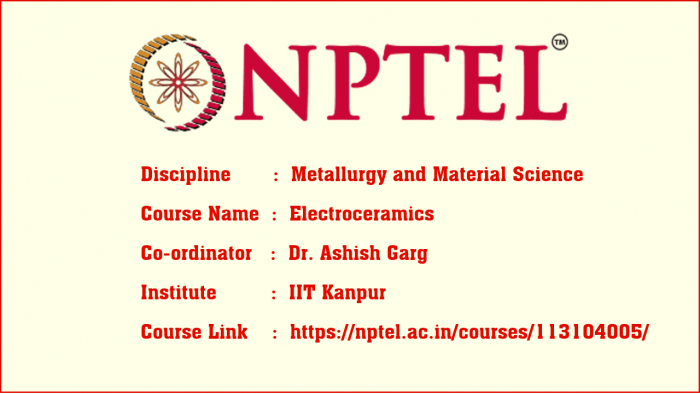
Media Storage Type : DVD-ROM
NPTEL Course Name : Electroceramics
NPTEL Subject Matter Expert : Dr. Ashish Garg
NPTEL Co-ordinating Institute : IIT Kanpur
NPTEL Lecture Count : 109
Lecture Titles:
Lecture 1 - Overview
Lecture 2 - Brief Review of Structure in Materials
Lecture 3 - A Brief Review of Bonding in Materials
Lecture 4 - Packing of Atoms in Metals
Lecture 5 - Interstices in Structures
Lecture 6 - Structure of Covalent Ceramics
Lecture 7 - Ionically Bonded Ceramic Structures
Lecture 8 - Compounds based on FCC Packing of Ions
Lecture 9 - Other Cubic Structures
Lecture 10 - Orthogonal Structures
Lecture 11 - Structures based on HCP Packing of Ions
Lecture 12 - Summary
Lecture 13 - Introduction
Lecture 14 - Point Defects
Lecture 15 - Krogerï¾–Vink notation in a metal oxide, (MO)
Lecture 16 - Defect Reactions
Lecture 17 - Defect Structures in Stoichiometric Oxides
Lecture 18 - Defect Structures in Non - Stoichiometric Oxides
Lecture 19 - Dissolution of Foreign Cations in an Oxide
Lecture 20 - Concentration of Intrinsic Defects
Lecture 21 - Intrinsic and Extrinsic Defects
Lecture 22 - Units for Defect Concentration
Lecture 23 - Defect Equilibria
Lecture 24 - Defect Equilibria in Stoichiometric Oxides
Lecture 25 - Defect Equilibria in Non-Stoichiometric Oxides
Lecture 26 - Defect Structures involving Oxygen Vacancies and Interstitials
Lecture 27 - Defect Equilibrium Diagram
Lecture 28 - A Simple General Procedure for Constructing a Brouwer\'s Diagram
Lecture 29 - Extent of Non-Stoichiometry
Lecture 30 - Example: Comparative Behavior of Titanium Dioxide and Magnesium Oxide vis-a-vis Oxygen Pressure
Lecture 31 - Electronic Disorder
Lecture 32 - Examples
Lecture 33 - Summary of Defect Chemistry and Defect Equilibria
Lecture 34 - Introduction
Lecture 35 - Diffusion
Lecture 36 - Diffusion Kinetics
Lecture 37 - Examples of Diffusion in Ceramics
Lecture 38 - Mobility and Diffusivity
Lecture 39 - Analogue to the Electrical Properties
Lecture 40 - Conduction in Ceramics vis-a-vis metallic conductors: General Information
Lecture 41 - Ionic Conduction: Basic Facts
Lecture 42 - Ionic and Electronic Conductivity
Lecture 43 - Characteristics of Ionic Conduction
Lecture 44 - Theory of Ionic Conduction
Lecture 45 - Conduction in Glasses
Lecture 46 - Fast Ion Conductors
Lecture 47 - Examples of Ionic Conduction
Lecture 48 - Electrochemical Potential
Lecture 49 - Nernst Equation and Application of Ionic Conductors
Lecture 50 - Examples of Ionic Conductors in Engineering Applications
Lecture 51 - Summary of Defects, Diffusion and Conduction in Ceramics
Lecture 52 - Introduction
Lecture 53 - Basic Properties: Dielectrics in DC Electric Field
Lecture 54 - Mechanisms of Polarization
Lecture 55 - Microscopic Approach
Lecture 56 - Determination of Local Field
Lecture 57 - Analytical Treatment of Polarizability
Lecture 58 - Effect of Alternating Field on the Behavior of a Dielectric Material
Lecture 59 - Frequency Dependence of Dielectric Properties: Resonance
Lecture 60 - Dipolar Relaxation i.e. Debye Relaxation in Polar Solids
Lecture 61 - Circuit Representation of a Dielectric and Impedance Analysis
Lecture 62 - Impedance Spectroscopy
Lecture 63 - Dielectric Breakdown
Lecture 64 - Basic mechanisms of breakdown
Lecture 65 - Summary of Dielectric Ceramics: Basic Principles
Lecture 66 - Introduction
Lecture 67 - Classification based on Crystal Classes
Lecture 68 - Ferroelectric Ceramics
Lecture 69 - Piezoelectric Ceramics
Lecture 70 - Pyroelectric Ceramics
Lecture 71 - Summary of Nonlinear Dielectrics
Lecture 72 - Introduction
Lecture 73 - Magnetic Moments
Lecture 74 - Macroscopic view of Magnetization
Lecture 75 - Classification of Magnetism
Lecture 76 - Diamagnetism
Lecture 77 - Paramagnetism
Lecture 78 - Ferromagnetism
Lecture 79 - Antiferromagnetic Materials
Lecture 80 - Ferrimagnetic Materials
Lecture 81 - A Comparison
Lecture 82 - Magnetic Losses and Frequency Dependence
Lecture 83 - Magnetic Ferrites
Lecture 84 - Summary of Magnetic Ceramics
Lecture 85 - Introduction
Lecture 86 - Background
Lecture 87 - Meissner Effect
Lecture 88 - The Critical Field, Hc
Lecture 89 - Theory of Superconductivity
Lecture 90 - Discovery of High Temperature Superconductivity
Lecture 91 - Mechanism of High Temperature Superconductivity
Lecture 92 - Applications
Lecture 93 - Summary of High temperature Superconductors
Lecture 94 - Introduction
Lecture 95 - Ferroic Material
Lecture 96 - Historical Perspective
Lecture 97 - Requirements of a Magnetoelectric and Multiferroic Material
Lecture 98 - Magnetoelectric Coupling
Lecture 99 - Type I Multiferroics
Lecture 100 - Type II Multiferroics
Lecture 101 - Two Phase Materials
Lecture 102 - Summary of Multiferroic and Magnetoelectric Ceramics
Lecture 103 - Introduction
Lecture 104 - Bulk Preparation Methods
Lecture 105 - Thin Film Preparation Methods
Lecture 106 - Thin film deposition: Issues
Lecture 107 - Summary of Synthesis Methods
Lecture 108 - Table of Contents
Lecture 109 - General Bibliography

